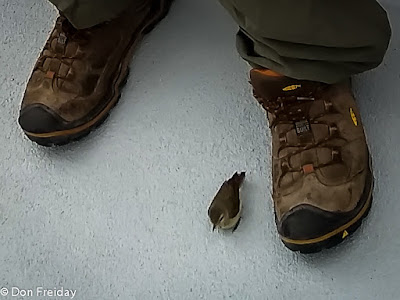Sunday, June 10, 2018
Why You Should go to Maine in June
[Above: Atlantic Puffins performing near Eastern Egg Rock, off famous Hog Island, during our June Joy of Birding program. Plenty of puffins and other alcids were also seen on the pelagic trip during the Acadia Birding Festival the week before. Click to enlarge all photos.]
I've fallen into the pleasant habit of birding coastal Maine every June. You can't lose: exciting seabirds, exciting landbirds, marine mammals, great scenery, great lobster . . . and for the events referenced above, outstanding leaders. We even found a Brown Booby in the Gulf of Maine during the Acadia Festival, and had one "get away" during the Hog Island camp.
The dates for Hog Island's joy of Birding camp will be June 2-9, 2019. The 2019 Acadia Festival will likely be the week before. Both are HIGHLY recommended.
[Above, Northern Parula, Harbor Porpoise (the most common inshore cetacean in Maine) and Red Squirrel, all at or near Hog Island, ME.]
Wednesday, May 23, 2018
Wayward Warbling Waif
[This tiny Warbling Vireo dropped onto our San Diego, CA pelagic trip boat last Sunday and wound up between my feet - about 20 miles offshore! Not an uncommon happening, having migrating landbirds take a break on a pelagic boat. The trip also featured Black-footed Albatross, Scripps' Murrelet, Black-vented AND Manx Shearwaters, and sightings of Guy McKaskie and Paul Lehman, new and old friends respectively.]
Friday, April 27, 2018
Ruff Day
[This male Ruff made the day at Heislerville WMA for me and friends. April 26, 2018. Click to enlarge.]
Sunday, March 18, 2018
In Another Country
[Common Redpolls love to feed on weed seeds. These are at Wisconsin's Crex Meadows Wildlife Area, a place I didn't even know existed a few weeks ago - and a place I will be returning to. Click to enlarge photos.]
Business had me traveling to the Great Lakes states last week - from the Rio Grande Valley, no less, where I visited friends, saw the wall (ugh) at Santa Ana, and shared my son Tim's excitement with all his lower Valley lifers, my old friends. By the way, White-collared Seedeaters were easy at Salineno. Just saying.
After notching my last two U.S. states (Oklahoma and Iowa), we arrived in far northwestern Wisconsin, we being me and Boone. It really felt like a different country: nice people, no traffic, wonderful woods and meadows, and a few northern birds despite the fact the land there is still snow covered and at night our frozen breath coated the inside of the truck cap. Birds like Northern Shrike, and the species pictured.
Monday, January 15, 2018
Ice-breaking Ferry
Friday, January 12, 2018
Fri-D: Scaup
I've said it for years, and I'll say it again: why, after almost 40 years of birding, studying every possible resource and every possible duck, do I still have trouble with telling Lesser Scaup from Greater Scaup?
Because it's not easy, that's why.
Let me walk that back a bit. I think I've got the scaup thing worked out pretty well, finally, but many times over the years very skilled birders have debated a scaup's identity right in front of me. And it. If only they could talk. The scaup, I mean.
So. I love it when they fly, because then the uncertainty virtually disappears. If the white on the wing pushes strongly out onto the primary feathers, as in the birds above, they are Greater Scaup. If it looks more like a "speculum," they are Lesser Scaup. Or, as Sibley puts it in his second edition field guide, "more white" and "less white." Brilliant. Using this mark requires one to know where the primaries and secondaries of the wing part ways, so study your field guides diagrams on bird topography.
These Greater Scaup flew past the 8th Street jetty in Avalon, NJ yesterday. Click to enlarge.
Monday, January 1, 2018
Winter Color: Last Photo of 2017
[Male Yellow-bellied Sapsucker, near Turkey Point, Cumberland County, NJ on New Year's Eve day, 2017. Click to enlarge.]
In winter, any splash of color is a welcome splash, and this sapsucker during the frigid Cumberland Christmas Bird Count sure was easy on the eyes.
In winter, any splash of color is a welcome splash, and this sapsucker during the frigid Cumberland Christmas Bird Count sure was easy on the eyes.
Subscribe to:
Posts (Atom)











